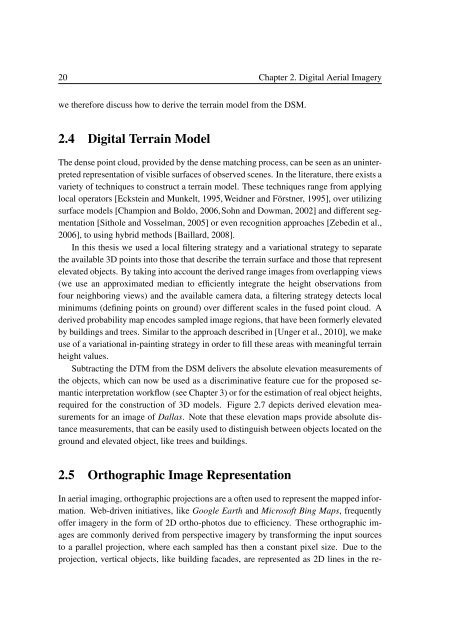Semantic Interpretation of Digital Aerial Images Utilizing ...
Semantic Interpretation of Digital Aerial Images Utilizing ...
Semantic Interpretation of Digital Aerial Images Utilizing ...
You also want an ePaper? Increase the reach of your titles
YUMPU automatically turns print PDFs into web optimized ePapers that Google loves.
20 Chapter 2. <strong>Digital</strong> <strong>Aerial</strong> Imagery<br />
we therefore discuss how to derive the terrain model from the DSM.<br />
2.4 <strong>Digital</strong> Terrain Model<br />
The dense point cloud, provided by the dense matching process, can be seen as an uninterpreted<br />
representation <strong>of</strong> visible surfaces <strong>of</strong> observed scenes. In the literature, there exists a<br />
variety <strong>of</strong> techniques to construct a terrain model. These techniques range from applying<br />
local operators [Eckstein and Munkelt, 1995, Weidner and Förstner, 1995], over utilizing<br />
surface models [Champion and Boldo, 2006,Sohn and Dowman, 2002] and different segmentation<br />
[Sithole and Vosselman, 2005] or even recognition approaches [Zebedin et al.,<br />
2006], to using hybrid methods [Baillard, 2008].<br />
In this thesis we used a local filtering strategy and a variational strategy to separate<br />
the available 3D points into those that describe the terrain surface and those that represent<br />
elevated objects. By taking into account the derived range images from overlapping views<br />
(we use an approximated median to efficiently integrate the height observations from<br />
four neighboring views) and the available camera data, a filtering strategy detects local<br />
minimums (defining points on ground) over different scales in the fused point cloud. A<br />
derived probability map encodes sampled image regions, that have been formerly elevated<br />
by buildings and trees. Similar to the approach described in [Unger et al., 2010], we make<br />
use <strong>of</strong> a variational in-painting strategy in order to fill these areas with meaningful terrain<br />
height values.<br />
Subtracting the DTM from the DSM delivers the absolute elevation measurements <strong>of</strong><br />
the objects, which can now be used as a discriminative feature cue for the proposed semantic<br />
interpretation workflow (see Chapter 3) or for the estimation <strong>of</strong> real object heights,<br />
required for the construction <strong>of</strong> 3D models. Figure 2.7 depicts derived elevation measurements<br />
for an image <strong>of</strong> Dallas. Note that these elevation maps provide absolute distance<br />
measurements, that can be easily used to distinguish between objects located on the<br />
ground and elevated object, like trees and buildings.<br />
2.5 Orthographic Image Representation<br />
In aerial imaging, orthographic projections are a <strong>of</strong>ten used to represent the mapped information.<br />
Web-driven initiatives, like Google Earth and Micros<strong>of</strong>t Bing Maps, frequently<br />
<strong>of</strong>fer imagery in the form <strong>of</strong> 2D ortho-photos due to efficiency. These orthographic images<br />
are commonly derived from perspective imagery by transforming the input sources<br />
to a parallel projection, where each sampled has then a constant pixel size. Due to the<br />
projection, vertical objects, like building facades, are represented as 2D lines in the re-















